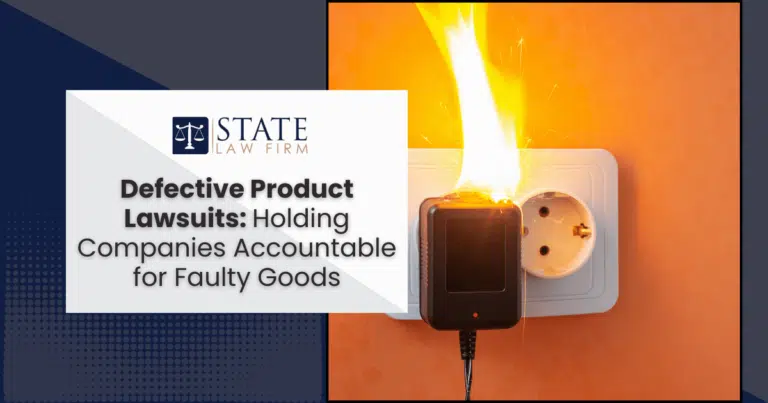Every year, thousands of people are affected by faulty or dangerous products, with the U.S. Consumer Product Safety Commission (CPSC) reporting that product-related injuries cost the U.S. an estimated $1 trillion annually in medical expenses, lost productivity, and other costs (source). Defective products can range from everyday household items to complex machinery, leaving consumers vulnerable to harm that is often entirely preventable. In these instances, legal action against responsible companies becomes crucial to hold them accountable and, ultimately, make consumer safety a priority.
At State Law Firm, we specialize in navigating the complexities of defective product lawsuits. Our team of young, driven attorneys brings a fresh perspective to personal injury law, and we’re committed to achieving justice for our clients who’ve suffered due to unsafe products. This article serves as a comprehensive guide to understanding defective product claims, equipping you with insights into the types of defects that can make products unsafe, the legal standards companies must meet, and the steps involved in holding manufacturers accountable. Whether you’re a consumer, a legal professional, or simply curious about your rights, we invite you to explore the evolving landscape of consumer protection and join us in advocating for safer products.
Understanding Defective Products: Types and Examples
A defective product is one that fails to meet reasonable safety expectations, posing risks to users and others. Product liability law holds companies accountable for ensuring that the products they manufacture, design, and market are safe. Understanding the three main types of defects can help consumers know what qualifies as a “defective product” and how liability is established in each category:
- Manufacturing Defects: These occur when something goes wrong in the production process, causing certain units to become dangerous or faulty. An example might be a batch of seatbelts failing to meet safety standards due to a mistake during assembly.
- Design Defects: Even if manufactured correctly, some products pose inherent risks due to flawed design. An example is a coffee maker that overheats, potentially causing burns.
- Marketing Defects (Failure to Warn): A product may be safe when used as directed, but without proper warnings or instructions, it can become hazardous. For instance, a medication lacking adequate warnings about potential side effects.
By familiarizing yourself with these defect types, you can better understand whether you have a viable claim. If you’ve experienced harm due to a defective product, it may be worth exploring legal options to seek compensation.
Pro Tip: Keep documentation of any warnings, instructions, and purchase receipts, as these can be valuable evidence when pursuing a defective product claim.
The Legal Framework Surrounding Defective Product Lawsuits
Product liability law is multifaceted, allowing consumers to seek justice through various legal principles, including negligence, strict liability, and breach of warranty. Here’s a breakdown of these key doctrines:
- Negligence: Proving that a company failed to exercise reasonable care in designing, manufacturing, or marketing a product.
- Strict Liability: In some cases, a company may be liable for injuries caused by a product regardless of fault, focusing solely on the defect and resulting harm.
- Breach of Warranty: If a product fails to meet the express or implied promises of safety and reliability, the manufacturer or seller may be held accountable.
Understanding these distinctions is critical to building a solid case. Our experienced attorneys can help you navigate these laws, offering guidance on the best approach to maximize your claim’s chances of success.
The Process of Filing a Defective Product Lawsuit: Step-by-Step Guide
Filing a defective product lawsuit involves several essential steps. Here’s a high-level overview:
- Assess Your Claim: Determine if the product defect caused injury or loss and consult a legal expert.
- Gather Evidence: Retain the defective product, receipts, and any documentation related to the defect, such as product recalls or safety warnings.
- File a Complaint: This formal legal document outlines your allegations, the type of defect, and your claims for damages.
- Negotiate or Proceed to Trial: Many cases settle outside of court, but having skilled representation is crucial if the case goes to trial.
Pro Tip: Start gathering evidence as soon as possible, as strong documentation often makes or breaks a case. Consider consulting with an attorney who can help streamline the process and ensure your rights are protected.
Proving Liability: What You Need to Know Before Taking Action
In a defective product lawsuit, the burden of proof lies with the plaintiff. Here’s what’s typically required:
- Proof of Defect: Showing that the product was defective in one of the three main ways (manufacturing, design, or marketing).
- Proof of Injury or Loss: Demonstrating that the defect led directly to injury or property damage.
- Expert Testimony: In many cases, experts are crucial for establishing that a product was unreasonably dangerous and caused harm.
Building a compelling case can be complex, especially when dealing with large companies and their legal teams. Our attorneys excel at securing reliable expert witnesses and compiling compelling evidence, helping level the playing field for our clients.
The Role of Expert Witnesses in Defective Product Cases
Expert witnesses can play a pivotal role in defective product lawsuits, especially in complex cases where technical details must be explained. These professionals help demonstrate how a defect caused harm, solidifying the evidence before the court. Experts often specialize in fields like engineering, manufacturing, or consumer safety, making them indispensable assets in high-stakes product liability cases.
Our team works with a network of reputable experts who are adept at testifying in court, helping strengthen your case and enhance your chances of a successful outcome.
A Comparison of Successful and Unsuccessful Defective Product Lawsuits
Learning from past cases can offer valuable insights. Here are a few examples that illustrate the potential outcomes of product liability cases:
- Successful Case: In a recent lawsuit, a manufacturer was held accountable when a consumer suffered burns due to a faulty space heater. The plaintiff won the case due to thorough documentation of the defect and expert testimony.
- Unsuccessful Case: In contrast, a case involving an alleged defect in a kitchen appliance was dismissed because the plaintiff couldn’t conclusively link the defect to their injury.
Each case is unique, but having strong evidence, compelling witnesses, and knowledgeable legal representation can increase the likelihood of a favorable result. Our attorneys are here to guide you through the nuances, helping you build a robust case from the start.
The Future of Consumer Protection: Trends in Defective Product Litigation
The landscape of consumer protection is continually evolving. Here are some trends to watch in defective product lawsuits:
- Increased Accountability: With heightened public awareness, companies are being held to higher standards for product safety and transparency.
- Technology’s Role: Advanced analytics and AI can trace defects faster and with greater precision, impacting both safety standards and litigation strategies.
- Legislative Changes: New regulations continue to emerge, offering more protections for consumers and higher penalties for negligent manufacturers.
By staying informed on these trends, consumers and attorneys alike can better advocate for safer, more accountable practices in product manufacturing. Our firm is dedicated to helping clients navigate this changing landscape, ensuring they receive fair treatment and compensation for injuries caused by defective products.


